Surely by now we’ve all heard about how important self-care is. But what are we actually doing about it?
I’ll wait…
Really, though! Why do we have to keep reminding each other to practice self-care? Why do we avoid it, and instead, keep putting ourselves in bad situations that quickly burn us out?
Saying “make sure to practice self-care and don’t feel like you’re being selfish when you do it” is, to make an understatement, uninformative and unhelpful.
Without providing a framework — like what sorts of activities, how often, in what setting — how could we ever expect someone to consistently do something they don’t know how to do? It’s a recipe for disaster.
When I first started college and was hearing a lot about self-care, I remember really appreciating that people were so committed to making personal well-being their first priority.
But that doesn’t change the fact that every time I heard the word “self-care,” I basically heard the word “bubble bath” in its place. The problem with that wasn’t that I didn’t have a bathtub, it was rather that I despise bubble baths (they make me feel trapped).
So my vision of what self-care was was pretty much just this:
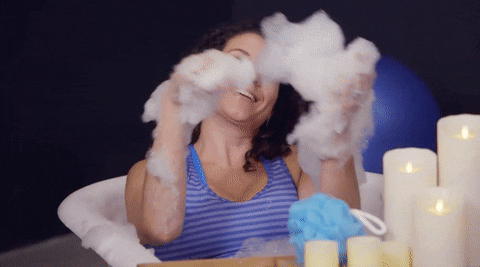
But thankfully that’s changed now – which means better self-care for me and better ideas to pass on to my lovely residents. As an RA to first-year students, I have become so enthralled with passing on nuggets of wisdom about self-care through anything from informal conversations to full-blown programs.
That’s because I deeply believe that when self-care is done well, it’s a self-empowering experience. We can empower them to empower themselves, and that’s exactly the point of student affairs’ work!
We want students to feel in control of themselves and be there for them as they learn important skills (like self-advocacy) that will continue to be useful. But let’s be real, there are lots of ideas about self-care floating around and we definitely don’t want to advocate for self-care practices that could actually be harmful.
So in this blog, I’ll share some misconceptions about self-care, some great things to widen our point of view, and finally, 10 ways to get that vision across through programming.
Common Misconceptions
The slogan of self-care has quickly become “treat yo’ self.” Lately, many people have been criticizing that, noticing that framing it that way means we might do things in the name of self-care that, in reality, do more harm than good. So, here are some things that are not always self-care (we’ll talk about better options later on).
1. Avoiding responsibilities
Catching a break is one thing, but avoiding our responsibilities completely and haphazardly without thinking toward the future can make us more anxious and make these tasks harder than they would otherwise be.
2. Relaxing completely
Along the same lines as thinking that a bubble bath would solve all of my problems (if only I liked them), low-energy and super-relaxing self-care for an entire day usually seems like the thing to do, but it might get in our way and make us feel less excited about getting done what we need to do.
3. Shopping
Eating meals out and shopping online can be amazingly cathartic and satisfying, but retail therapy can be destructive if it means impulsively buying and getting off-budget.
4. Binging
Zoning out and doing mindless activities – like watching a whole season of a show on Netflix – can definitely feel relaxing, but also be a way to escape rather than actually enjoy what’s happening. Similarly, overindulging in alcohol serves as an unhealthy coping mechanism.
Obviously “treating ourselves” as it goes can create problems of its own when it’s focused on completely unplugging and detaching. A lot of times that’s because it feels impossible to let go that much and be in a state of pure bliss, making this feel really #relatable:
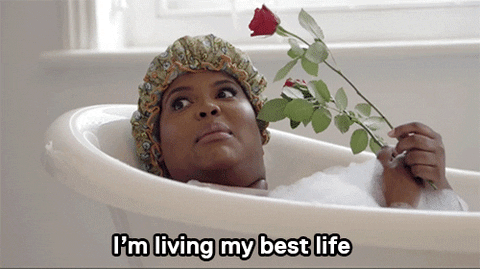
So, what should self-care look like then? How can we quit falling into these traps and give ourselves the care that we need and deserve?
Redefining Self-Care
My self-care “a-ha” moment was when I realized that real self-care™ is doing things that make oneself feel truly cared for and present. It sounds super obvious, but thinking about it this way dispels a lot of the confusion right away.
Self-care is a process of building a relationship with ourselves and loving ourselves. It’s a way of life: consistently doing things to affirm our worth, letting ourselves know we appreciate and accept ourselves for who we are.
It shouldn’t get in our ways and disturb our workflow, but rather re-energize us to keep us going. Following through with our careers and passions helps us feel a sense of purpose, so self-care practices definitely shouldn’t be getting in the way of all that good stuff.
Overall, in order to build that strong relationship with ourselves, we need to know ourselves. It’s about recognizing what areas of life are lacking and could use more attention in order to feel more connected to ourselves and to life. We might need some excitement and stimulation, some reflection, or even greater connection.

We also need to be responsive to how we’re feeling in the moment. Self-care isn’t only proactive. We can use it in response to how we’re feeling: to help us get up out of a rut by shaking up stagnant, negative feelings or to slow down and comfort ourselves. Ultimately, we’re in control. Noticing both where our energy level is and where we want it to be allows us to tailor our practices accordingly.
Staying connected with our support network and actively working on repairing and building relationships puts us in a position to seek help when we need it rather than being left feeling alone and hopeless. Seeking professional therapy can also be an important part of a self-care routine.
Using this framework, there are some ways to create self-care events that are actually beneficial to students in the long run.
10 Self-Care Program Ideas
As you might imagine, self-care can come in a lot of forms. As long as it gets at healthy and happy living that shows us love, appreciation, and lifts us up, it can be a great practice.
And that’s good news for student affairs professionals and RAs who want to approach this topic with college students and promote self-care practices. This is no small task, because we want it to be an accurate and helpful image of self-care and also have it be engaging and budget-friendly.
So here are some ways to do it:
1. Share and discuss the wellness wheel
The wellness wheel is a great resource for visualizing the various domains of wellness and practices associated with each domain. It gets people thinking about what counts as self-care and provides concrete ideas to try.
When I did this with students, we were all surprised at some of the things that were listed as self-care because some were low energy, some were high energy, and some, honestly, even seemed more like chores.
You can create a quiz so students can more easily identify areas of wellness they should focus on. They can then work to create an action plan inspired by the ideas on the wheel and ones generated by the group or with the facilitator.
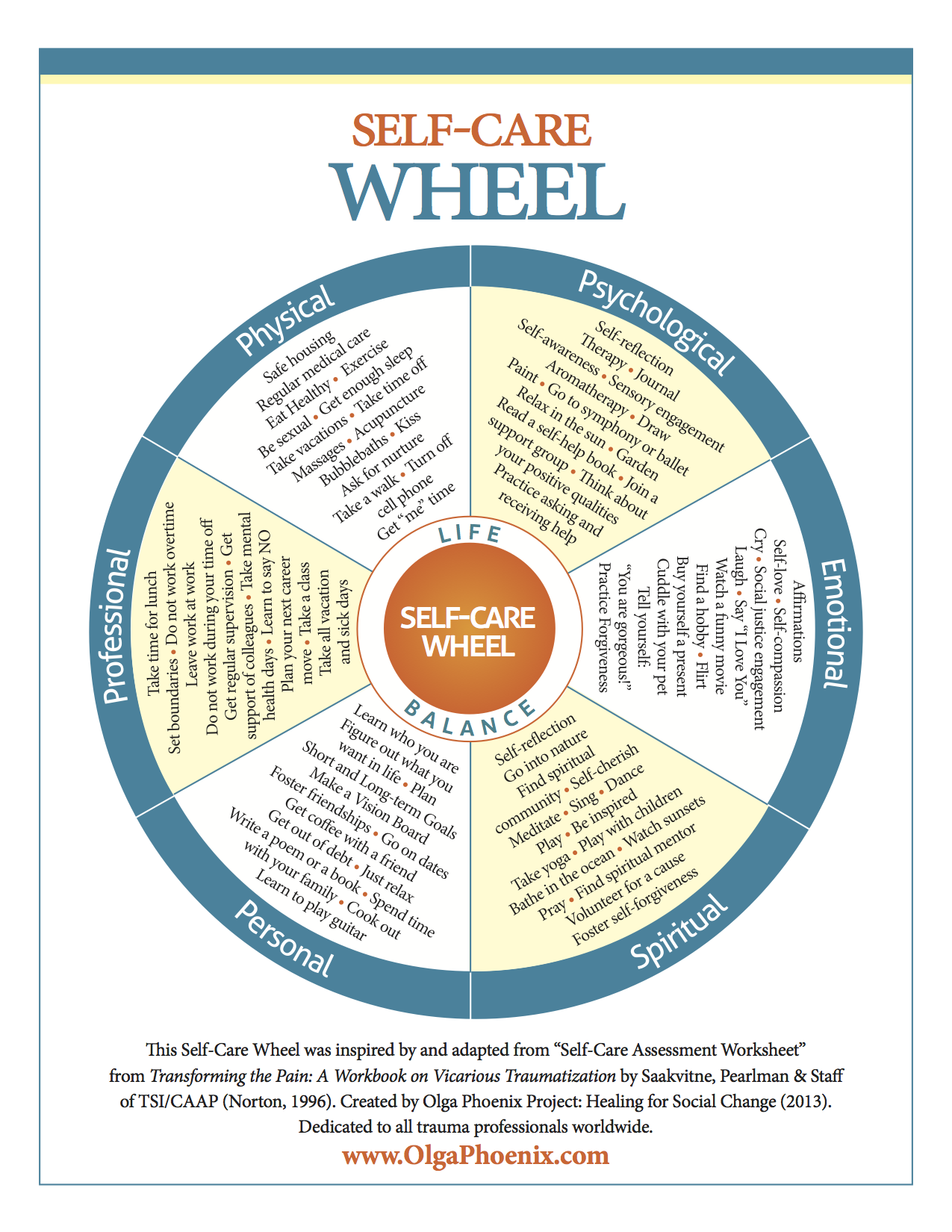
2. Transform study breaks into self-care
It’s wild how many self-care practices can be easily integrated into our daily routine. They’re often tiny tasks that make things so much easier. Who knew productive study breaks could make us feel so good?
Encourage students to proactively create a list of small tasks — like spending ten minutes to learn more about loans, make a budget, or tidy their workspace – that they feel will bring them relief and enthusiasm. They can write their ideas on slips of paper, put them in a jar, and keep it on their desk while they’re working for easy access.
3. Encourage reflection with self-love worksheets
Worksheets can be the next step in getting students to engage more meaningfully and personally with self-care. They’re great for building self-knowledge because they’re a space made for explicit reflection on one’s values, feelings, aspirations, growth, appreciation, and more.
Once they’re filled out, they can serve as a great reference when someone knows they could use some care, but could use some centering and reminders about what they want so they can see what is in reach for them. Having this posted somewhere can be a helpful reminder.

Image by Sacha Chua
4. Identify, set and maintain boundaries.
Boundary setting is proactive self-care, but we usually have to have our potential boundaries broken before we create formal boundaries that address these concerns. Holding a key relationship or two of their choosing (ex: with family, romantic partners, co-workers, etc.) in mind, students can learn more about what boundaries look like and what they can do for themselves.
Once potentially-helpful boundaries are identified, you can pay special attention and work through how people feel about communicating these boundaries. This is a part of self-care that can feel really selfish and unnatural because we expect that in love we should strive to make the other person happy.
You’d work to bust the myth that you have to be cold and detached when you set boundaries, instead, showing how to work through conflict more kindly and lovingly. Students should come out of the session feeling more inclined to hold to their boundaries when they’re being pushed against, rather than caving in to them.
5. Create affirmations together
Positive words of encouragement are uplifting even when they come from our own selves. After all, we do have greater insight into what sorts of encouragement feels best.
Give students materials for them to create their own slogans, pieces of art to hang up in their rooms, or even buttons to put on their bags so they can externalize their self-love. Hold space for them to share what makes a good affirmation for them.
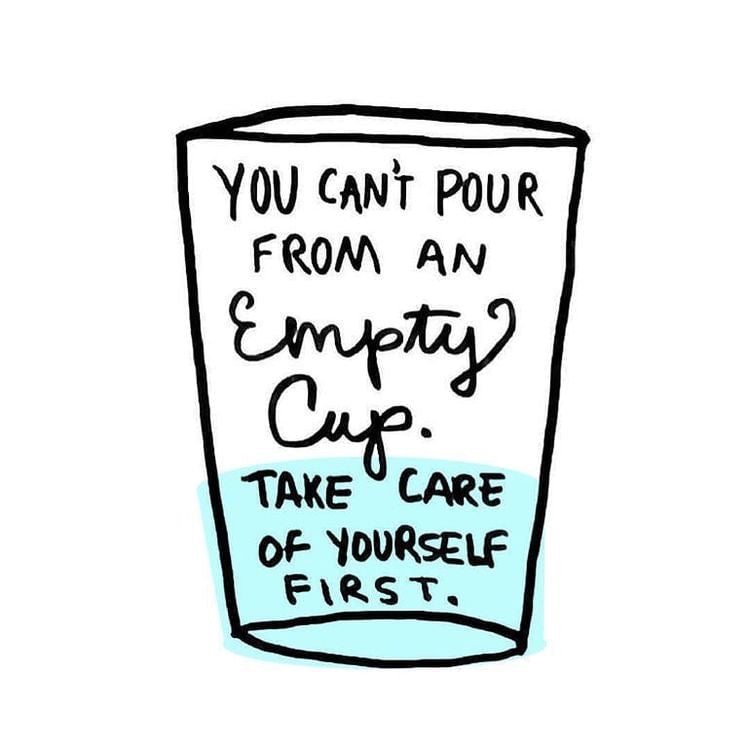
6. Explain how stress really works
The experience of stress has a lot to do with our bodily reactions. So once we’ve been stressed about a big assignment and then we finally complete it, it’s really important that we signal to our bodies that we are safe and that all is well. We do that by ending our stress cycle, rather than feeling constantly trapped in it.
Providing this information, as well as a list of ways to effectively end a stress cycle, provides a useful concept paired with practical solutions. Some ways to complete a stress cycle include dancing around, having a good cry, primal screaming, grooming, and sharing affection. Knowing healthy ways to cope with stress is an inherent part of self-care.
7. Teach caretaking with plants
Along the same lines of it being easier to see things in other people than we can in ourselves, practicing caretaking in a low-risk situation can be a very comforting and grounding part of a routine. Students focus on learning to nurture something else with an intention of understanding more deeply how essential it is we care for ourselves, too.
Parallels can be drawn between caring for a plant and caring for ourselves.
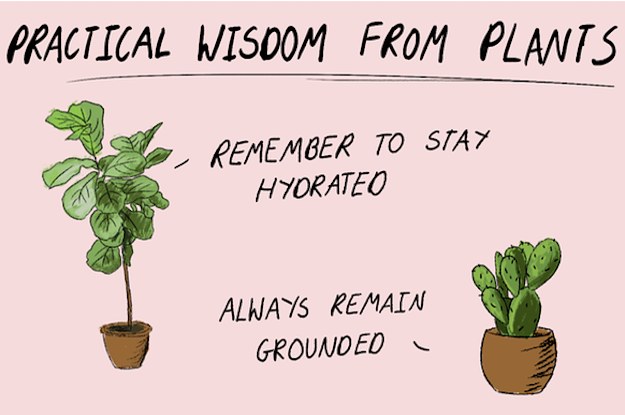
Image by Natalya Lobanova
8. Promote mindful living
Rather than detaching, focusing on completing tasks mindfully can really center us and make life more enjoyable. Mindfulness meditation asks us to focus on breathing, but you can also do this with painting and journaling, as a few examples. The objective would be to get students thinking about ways they can stay in touch with themselves throughout the day, week, and so on, by doing things that tune them in to the ways their bodies are feeling.
9. Think about motivation
Especially as students get to the end of the semester, tasks can feel so hard because motivation can be at an all-time low (and no, I don’t mean that one band). Encouraging students to freshen up the ways they’re approaching themselves and their work is an excellent way for them to stay up on their self-care throughout finals.
Refraining from comparing our progress to that of others, breaking our giant assignments into smaller ones, reminding ourselves of all the great things we’ve accomplished in our lives thus far…these are all great strategies we can pass on to students.
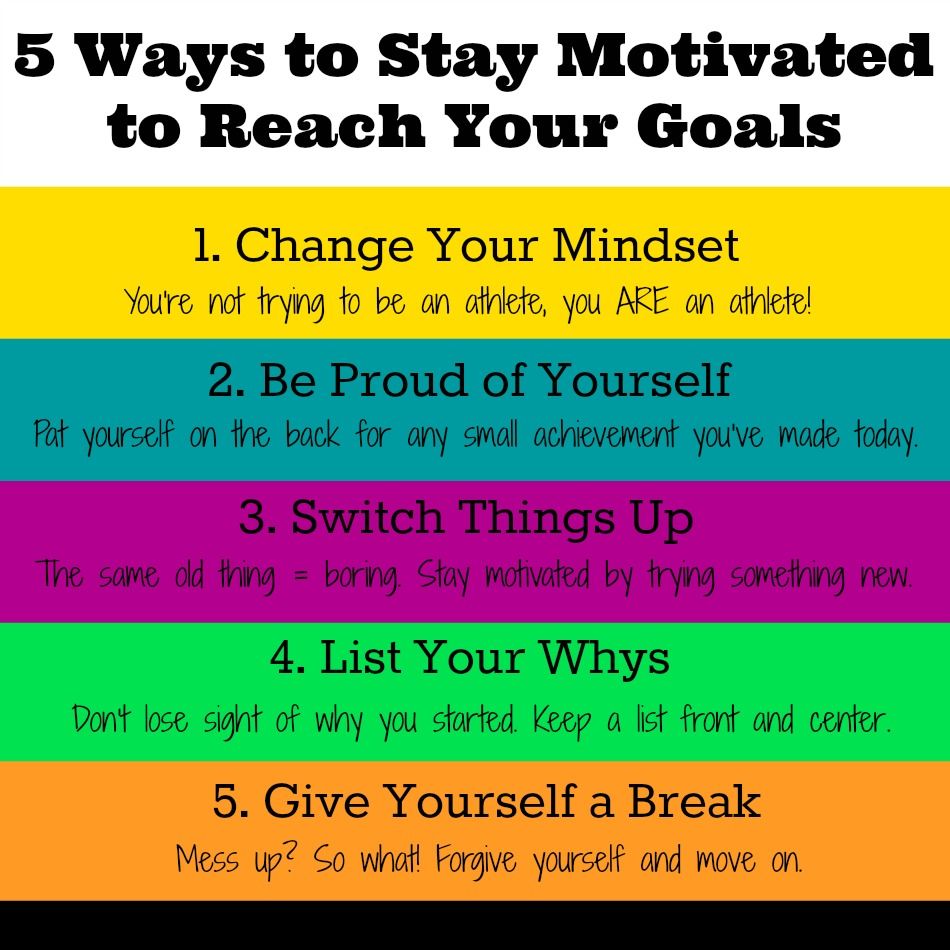
10. Exercise together.
Getting your blood pumping is a natural way for your body to feel great, so including exercise in our self-care ideas is crucial, but so is acknowledging that getting to the gym can be hard. Advertising recurring fitness classes as a way to get in your regular self-care is great. Also giving a list of exercises that students can do in their rooms is a good way to get started.
We that hope that you and your students can get to feeling like this:

How do you feel about self-care now? It’s a process so be gentle with yourself. Let us know how you’re using this with your students by tweeting at @themoderncampus!





